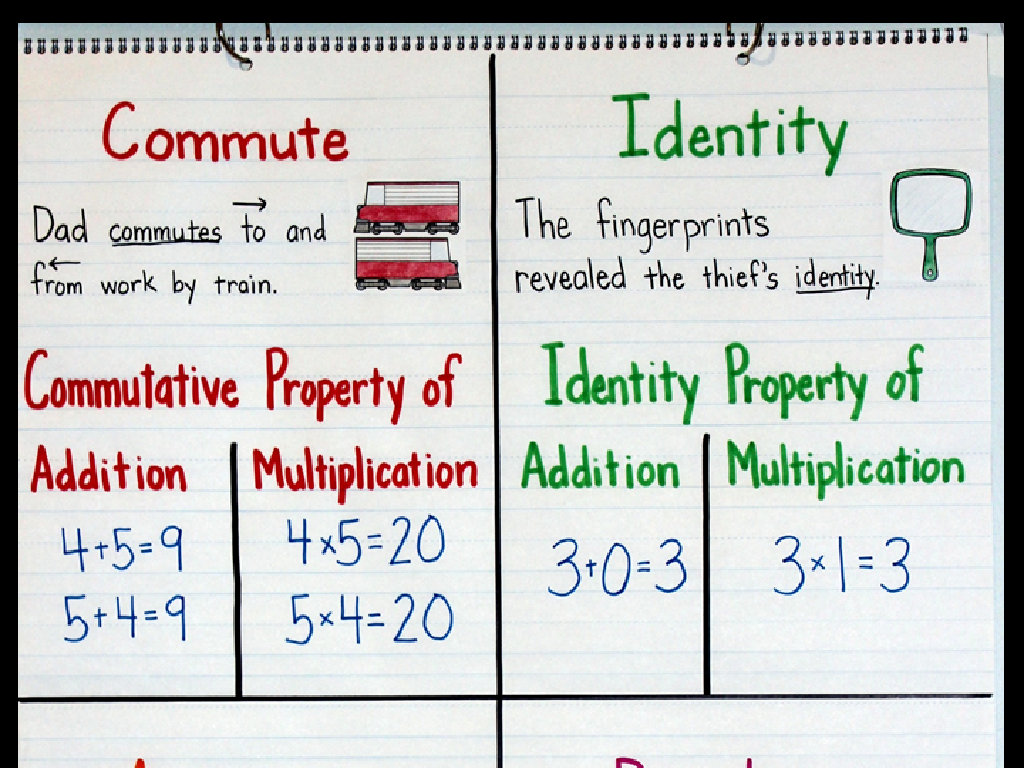Add And Subtract Decimals: Word Problems
Subject: Math
Grade: Fourth grade
Topic: Add And Subtract Decimals
Please LOG IN to download the presentation. Access is available to registered users only.
View More Content
Welcome to Decimals!: Adding and Subtracting
– Explore adding & subtracting decimals
– Decimals represent parts of a whole
– Like pieces of a chocolate bar broken into 10 pieces
– Use decimals in money & measurements
– Think of buying candy with $1.50 or measuring 1.75 liters of water
– Practice with real-world problems
– How much change from $5 for a $2.25 ice cream?
|
This slide introduces students to the concept of decimals in the context of addition and subtraction. Begin by explaining that decimals are a way to represent fractions and parts of a whole, using the analogy of a chocolate bar to make it relatable. Discuss how decimals are used in everyday life, such as in money transactions and measurements. Provide examples that are easy to visualize and relevant to the students’ experiences, like buying items or measuring liquids. Encourage students to think of other examples where they encounter decimals. The slide sets the stage for engaging with word problems that apply these concepts, helping students to see the practical importance of understanding how to add and subtract decimals.
Understanding Decimals
– What is a decimal?
– A number with a decimal point, separating whole and parts
– Whole numbers vs. decimal parts
– Numbers left of the point are whole, right are fractional
– Exploring place values
– Place values determine a digit’s value
– Tenths, hundredths, thousandths
– Examples: 0.1 (tenths), 0.01 (hundredths), 0.001 (thousandths)
|
This slide introduces the concept of decimals to fourth-grade students. Begin by explaining that a decimal is a special type of number that includes a decimal point. This point separates the whole number part from the fractional part. Emphasize the importance of place value, which helps us understand the value of each digit in a decimal number. Use visual aids to show the place values of tenths, hundredths, and thousandths, and provide simple examples for each. Encourage students to think of money as a real-life example, where one dollar is a whole and cents are parts of a whole. This foundational understanding will be crucial as they learn to add and subtract decimals in word problems.
Adding Decimals: Step by Step
– Line up decimal points first
– Add like whole numbers
– Place decimal in the answer
– Example problem on the board
– We’ll add 3.75 + 1.2 together as a class
|
This slide introduces the concept of adding decimals, which is similar to adding whole numbers but requires careful placement of the decimal point. Start by explaining the importance of aligning the decimal points vertically before adding, as this ensures that the tenths, hundredths, and thousandths places are correctly positioned. Emphasize the need to bring the decimal point straight down into the answer. After explaining the steps, engage the class with a board example, such as 3.75 + 1.2. Walk through the process step by step, demonstrating how to align the decimal points, add the numbers as if they were whole numbers, and then place the decimal point in the correct spot in the answer. This interactive example will help solidify the concept for the students.
Subtracting Decimals in Word Problems
– Line up the decimal points
– Subtract like whole numbers
– Decimal point in answer aligns
– Practice with real examples
– If you buy a toy for $5.65 and pay with a $10 bill, how much change do you get?
|
When teaching students to subtract decimals, start by emphasizing the importance of aligning the decimal points, which is similar to the process in addition. This ensures that the tenths, hundredths, and thousandths places are correctly lined up. After aligning, they should subtract as if they are dealing with whole numbers, ignoring the decimal point during the calculation. Remind them to place the decimal point in the answer directly beneath the decimal points above to maintain the correct value. Use real-world examples like money transactions to illustrate the concept, as this is both relatable and practical for fourth graders. Encourage students to solve problems involving decimal subtraction and to check their work by adding the difference to the smaller number to see if it equals the larger number.
Decimals in Word Problems
– Word problems relate math to the real world
– Key steps to solve decimal problems
– Read the problem, find the numbers, and choose to add or subtract
– Example: Adding decimals in a problem
– If Lucy has $5.75 and earns $2.50, how much does she have now?
– Example: Subtracting decimals in a problem
– If Max has $9.60 and spends $3.25, how much is left?
|
This slide introduces students to the concept of using decimals in word problems, which helps them apply mathematical operations to real-life situations. Emphasize the importance of understanding the context of the problem and identifying whether to add or subtract. Walk through the examples provided, demonstrating how to break down the problem into manageable steps: reading the problem, identifying the numbers involved, and choosing the correct operation based on the situation. Encourage students to visualize the scenarios with money, as it’s a relatable context for them. In the next class, students will be asked to solve similar problems and explain their reasoning.
Let’s Practice: Adding & Subtracting Decimals
– Pair up for decimal practice
– Use place value knowledge
– Remember each place value position when adding or subtracting
– Solve decimal addition & subtraction
– Example: 3.75 + 2.6, align the decimals and add
– Discuss solutions with the class
|
This slide is designed to encourage collaborative learning through pair work. Students should use their understanding of place value to accurately add and subtract decimals. Provide them with a set of word problems that require decimal operations. Encourage them to discuss their strategies and how they use place value in their calculations. After solving the problems, pairs will share their answers and methods with the class, allowing for group discussion and peer learning. This activity will help solidify their understanding of decimal operations in the context of real-world scenarios.
Class Activity: Decimal Scavenger Hunt
– Find items with decimal prices
– Work in groups to calculate totals
– Add up the prices to find a total cost
– Subtract prices of different items
– Use subtraction for price comparisons
– Present and explain your findings
– Share your methods and answers with the class
|
This interactive activity is designed to help students apply their knowledge of adding and subtracting decimals in a fun and engaging way. By searching for items around the classroom with decimal prices, students will work collaboratively in small groups to practice their arithmetic skills. They will add up prices to find total costs and use subtraction to compare the prices of different items. After the calculations, each group will present their findings to the class, explaining the methods they used and the answers they found. This will reinforce their understanding of decimal operations and enhance their presentation skills. For the teacher: Prepare labels with decimal prices and place them on various classroom items beforehand. Ensure that the groups are balanced and that each student has the opportunity to participate in the calculations and presentation.
Conclusion & Homework: Decimals Mastery
– Excellent work on decimal operations!
– Practice with homework assignments
Homework will reinforce today’s lesson on adding and subtracting decimals.
– Address any final questions
Now’s the time to ask if anything from today’s lesson is unclear.
– Keep practicing at home!
|
As we conclude today’s lesson on adding and subtracting decimals, it’s important to acknowledge the students’ efforts and encourage them to continue practicing with their homework. The homework is designed to reinforce the concepts learned in class and provide additional practice with word problems involving decimal operations. Remind students that practice is key to mastery. Before ending the session, open the floor for any questions to clarify doubts and ensure understanding. Encourage students to approach problems methodically and to check their work for accuracy. For homework, provide a variety of word problems that require both adding and subtracting decimals, ensuring that the problems are at an appropriate difficulty level for fourth graders.






